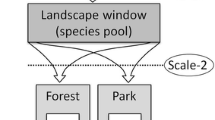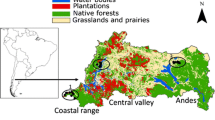Abstract
Bats play an important role in the ecosystem as seed dispersers, pollinators and pest controllers. In particular, frugivorous bats are important for regeneration processes in open and degraded areas, because they disperse the seeds of pioneer plant species, which are essential for succession. Depending on the type of habitat that is established at the fragment edge, resources and bat movement patterns toward open areas can be affected. The structure and composition of bats was compared between two ‘interior-edge-pasture’ gradients, in an Andean forest fragment located at the Reserva Natural la Montaña del Ocaso (Quindío, Colombia). The two edge-types considered were forest-edge and bamboo-edge (Guadua angustifolia, Poaceae), both located in the same fragment. Bat abundance was significantly different in the two edge habitats. The forest-edge is a soft edge, in that it allows bat species to move from the interior of the forest to the pasture in front of it. In contrast, the bamboo-edge can be defined as semi-permeable, because it allows less movement of species and individuals from the interior to the pasture. Here we evaluate the possible effects of habitat edge type on bat movement in degraded areas in the main coffee producing region of Colombia.




Similar content being viewed by others
References
Bernard E, Fenton MB (2003) Bat mobility and roosts in a fragmented landscape in central Amazonia, Brazil. Biotropica 35:262–277
Bonaccorso FJ, Winkelmann JR, Shin D, Agrawal CI, Aslami N, Bonney C, Menesale SA, Richards JH, Rutland JA, Sessa AK, Zhaurova L, Kunz TH (2007) Evidence for exploitative competition: comparative foraging behavior and roosting ecology of short tailed fruit bats (Phyllosmidae). Biotropica 39:249–256
Cadenasso ML, Pickett STA (2001) Effect of edge structure on the flux of species into forest interiors. Conserv Biol 15:91–97
Cadenasso ML, Pickett STA, Weathers KC, Jones CG (2003) A framework for a theory of ecological boundaries. Bioscience 53:750–758
Camargo JC, Dossman MA, Cardona G, Garcia JH, Arias LM (2007) Zonificación detallada del recurso guadua en el eje cafetero, Tolima y Valle del Cauca. CARDER - CVC - CRQ - CORTOLIMA - UTP - Ministerio de Ambiente, Vivienda y Desarrollo
Colwell RK (2005) EstimateS: statistical estimation of species richness and shared species from samples. Version 7.5. Persistent URL http://purl.oclc.org/estimates. Cited: 10 Nov 2008
Estrada-Villegas S, Pérez-Torres J, Stevenson P (2007) Dispersión de semillas por murciélagos en un borde de bosque montano. Ecotropicos 20:1–14
Etter A (1998) Mapa General de Ecosistemas de Colombia. Escala 1: 2′000.000. IAvH y PNUD, Bogotá
Fagan WF, Cantrell RS, Cosner C (1999) How habitat edges change species interactions. Am Nat 153:165–182
Fleming TH (1982) Foraging strategies of plant visiting bats. In: Kunz TH (ed) Ecology of bats. Plenum Press, New York
Galindo-González J (1998) Dispersión de semillas por murciélagos: su importancia en la conservación y regeneración del bosque tropical. Acta Zool Mex 73:57–74
Galindo-González J, Sosa VJ (2003) Frugivorous bats in isolated trees and riparian vegetation associated with human-made pastures in a fragmented tropical landscape. Southwest Nat 48:579–589
Galindo-González J, Guevara S, Sosa VJ (2000) Bat and bird generated seed rains at isolated trees in pastures in a tropical rainforest. Conserv Biol 14:1693–1703
Gannon WL, Sikes RS (2007) Guidelines of the American Society of Mammalogist for the use of wild mammals in research. J Mammal 88:809–823
Griscom BW, Ashton PMS (2006) A self-perpetuating bamboo disturbance cycle in a neotropical forest. J Trop Ecol 22:587–597
Harper KA, Macdonald SE, Burton PJ, Chen J, Brosofske KD, Saunders SC, Euskirchen ES, Roberts D, Jaiteh MS, Esse P (2005) Edge influence on forest structure and composition in fragmented landscapes. Conserv Biol 19:768–782
Harrison RD (2005) Figs and the diversity of tropical rainforest. Bioscience 55:1053–1065
Heithaus ER (1982) Coevolution between bats and plants. In: Kunz TH (ed) Ecology of bats. Plenum Press, New York
Hoffer SR, Solari S, Larsen PA, Bradley RD, Baker RJ (2008) Phylogenetics of the fruit-eating bats (Phyllostomidae: Artibeina) inferred from mitochondrial DNA sequences. Occas Pap Mus Tex Tech Univ 277:1–15
Jongman RR, ter Braak CJF, van Tongeren OFR (1995) Data analysis in community and landscape ecology, 2nd edn. Cambridge University Press, Cambridge
Kusch J, Weber C, Idelberger S, Koob T (2004) Foraging habitat preferences of bats in relation to food supply and spatial vegetation structures in a western European low mountain range forest. Folia Zool 53:113–128
Laurance WF, Lovejoy T, Vasconcelos H, Bruna E, Didham R, Stouffer P, Gascon C, Bierregaard R, Laurance SG, Sampaio E (2002) Ecosystem decay of Amazonian forest fragments: a 22-year investigation. Conserv Biol 16:605–618
López-Barrera F, Manson RH, González-Espinosa M, Newton AC (2007) Effects of varying forest edge permeability on seed dispersal in a neotropical montane forest. Landsc Ecol 22:189–203
Magurran A (2004) Measuring biological diversity. Blackwell Science, USA
Medellín R, Gaona O (1999) Seed dispersal by bats and birds in forest and disturbed habitats of Chiapas, México. Biotropica 31:478–485
Medina A, Harvey CA, Merlo DS, Vilchez S, Hernandez B (2007) Bat diversity and movement in an agricultural landscape in Matiguas, Nicaragua. Biotropica 39:120–128
Meyer CFJ, Fründ J, Pineda-Lizano W, Kalko EKV (2008) Ecological correlates of vulnerability to fragmentation in neotropical bats. J Appl Ecol 45:381–391
Moenting AE, Morris DW (2006) Disturbance and habitat use: is edge more important than area? Oikos 115:23–32
Morrison DW (1978) Foraging ecology and energetics of the frugivorous bat Artibeus jamaicensis. Ecology 59:716–723
Murcia C (1995) Edge effects in fragmented forest: implications for conservation. Trends Ecol Evol 19:58–62
Pérez-Torres J (2004) Dinámica del ensamblaje de murciélagos en respuesta a la fragmentación en bosques nublados: un modelo de ecuaciones estructurales. Ph.D. Dissertation, Pontificia Universidad Javeriana
Ranney J, Bruner M, Levenson J (1981) The importance of edge in the structure and dynamics of forest islands. In: Burgess R, Sharpe D (eds) Forest islands dynamics in man dominated landscapes. Springer, New York
Rodríguez G, Arango O (2004) Caracterización general. In: Rodríguez G, Arango O (eds) Ciudad región eje cafetero hacia un desarrollo urbano sostenible. Gráficas Jes Ltda, Manizales
Simmons NB (2005) Order Chiroptera. In: Wilson DE, Reeder DM (eds) Mammal species of the world. A taxonomic and geographic reference, vol 1. The Johns Hopkins University Press, USA
Soberon J, Llorente-Bousquets J (1993) The use of species accumulation functions for prediction of species richness. Conserv Biol 7:480–488
Soriano PJ (2000) Functional structure of bat communities in tropical rainforests and Andean cloud forests. Ecotropicos 13:1–20
Stamps JA, Buechner M, Krishnan VV (1987) The effects of edge permeability and habitat geometry on emigration from patches of habitat. Am Nat 129:533–552
STATSOFT Inc (2001) Statistica (data analysis software system), version 6. www.statsoft.com
Varela A (2004) Efecto de la fragmentación sobre la producción y descomposición de la hojarasca en bosque altoandino nublado: patrones, mecanismos y modelos. Ph.D. Dissertation, Pontificia Universidad Javeriana
Verboom B, Spoelstra K (1999) Effects of food abundance and wind on the use of tree lines by an insectivorous bat, Pipistrellus pipistrellus. Can J Zool 77:1393–1401
Williams-Linera G (1991) Los bordes de selvas y bosques. Ciencia y desarrollo 17:65–71
Acknowledgments
German Dario Gomez (University of Quindío) provides access to the reserve and the logistical support during our stay. We are very grateful to Daniel Rodríguez, Catalina Sánchez-Lalinde and Laura Pérez-Pabón for their assistance while collecting data in the field. We are also grateful to Vinicio Sosa, Nicolás Urbina, Jorge Galindo, Sergio Estrada, Jeffrey Wielgus, Larry Jimenez-Ferbans and an anonymous reviewer for their detailed and useful comments on previous drafts of this paper. This study was supported by the Laboratorio de Ecología Funcional of the Pontificia Universidad Javeriana and made part of the project “Factors controlling the assemblage of tropical bats: trophic breadth and resource partitioning” funded by the Pontificia Universidad Javeriana (ID 000660).
Author information
Authors and Affiliations
Corresponding author
Rights and permissions
About this article
Cite this article
Cortés-Delgado, N., Pérez-Torres, J. Habitat edge context and the distribution of phyllostomid bats in the Andean forest and anthropogenic matrix in the Central Andes of Colombia. Biodivers Conserv 20, 987–999 (2011). https://doi.org/10.1007/s10531-011-0008-1
Received:
Accepted:
Published:
Issue Date:
DOI: https://doi.org/10.1007/s10531-011-0008-1




